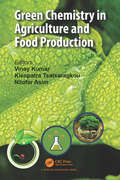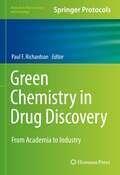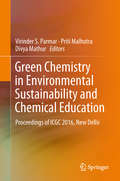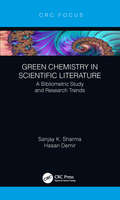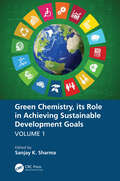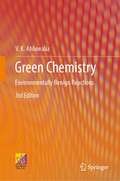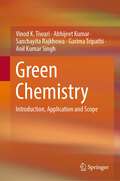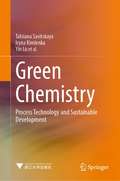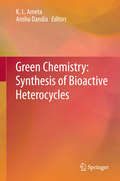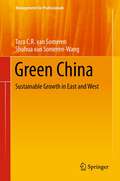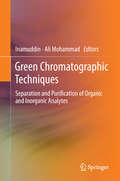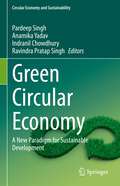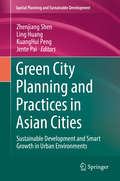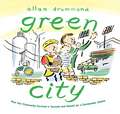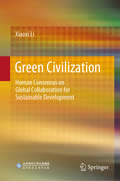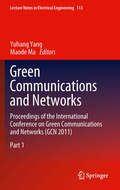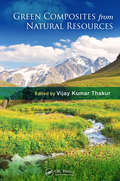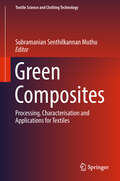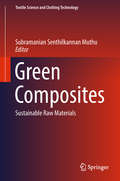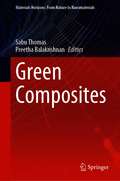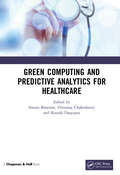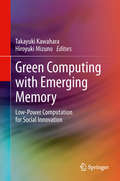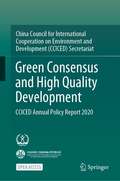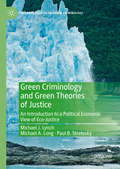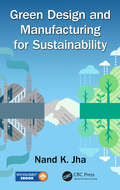- Table View
- List View
Green Chemistry in Agriculture and Food Production
by Vinay Kumar Kleopatra Tsatsaragkou Nilofar AsimGreen chemistry is a vital subject playing a key role in environmental sustainability. Despite its importance, very little has been explored in the past years. This book is a comprehensive compilation of the methods, techniques and strategies used in green chemistry. The book highlights some critical aspects of green chemistry related to agriculture and food production. It has been put together for undergraduate, graduate, and postgraduate students. Each chapter has been cited with new and updated research discoveries to help the postgraduate, and doctorate students and researchers. I hope the presented book will be an important tool for students and researchers.
Green Chemistry in Drug Discovery: From Academia to Industry (Methods in Pharmacology and Toxicology)
by Paul F. RichardsonThis detailed book highlights several emerging areas in the implementation of green chemistry in medicinal chemistry drug discovery with a specific focus on their application to the expeditious discovery of new biologically active entities. Divided into three sections, the collection explores greener approaches to chemical transformations that are both prevalent and have been highlighted as challenging within the pharmaceutical industry, overall synthetic strategy, as well as the implementation and impact of a range of enabling technologies within medicinal chemistry. As a volume of the Methods in Pharmacology and Toxicology series, chapters provide the kind of key insight that can guide researchers toward greater success in the lab. Authoritative and practical, Green Chemistry in Drug Discovery: From Academia to Industry provides both a fundamental insight into the progress that has been made as well as some of the challenges that still exist for these techniques to be effectively implemented in the drug discovery process in a routine manner.
Green Chemistry in Environmental Sustainability and Chemical Education: Proceedings of ICGC 2016, New Delhi
by Virinder S. Parmar Priti Malhotra Divya MathurChemistry is considered to be one of the prime causes of environmental pollution and degradation. The United Nations General Assembly also addressed the environmental challenges in its Sustainable Development Goals (SDGs), which have been adopted in 2015. A closer look shows that to meet these goals chemistry will play an important role. Green chemistry encompasses design and synthesis of environmentally benign chemical processes, green approaches to minimize and/or remediate environmental pollution, the development of biomaterials, biofuel, and bioenergy production, biocatalysis, and policies and ethics in green chemistry. When products in use today become waste, we need to treat that waste so that hazardous substances are not re-circulated into new products. In this context, circular economy is also an important point of discussion, which focuses on recycling, reuse and use of renewable sources.The theme of the International Conference on "Green Chemistry in Environmental Sustainability & Chemical Education (ICGC-2016) held in Delhi from 17-18 November 2016 was to discuss the emerging green trends in the direction of sustainability and environmental safety. ICGC-2016 consisted of keynote, plenary and invited lectures, panel discussion, contributed oral papers and poster presentations. The conference provided a platform for high school students, undergraduate and postgraduate students, teaching fraternity and young researchers to interact with eminent scientists and academicians from all over the world who shared their valuable views, experience and research on the harmonious methods in chemistry for a sustainable environment. This volume of proceedings from the conference provides an opportunity for readers to engage with a selection of refereed papers that were presented during the ICGC-2016 conference. The overarching goal of this book is to discuss most recent innovations and concerns in green chemistry as well as practical challenges encountered and solutions adopted to remediate a scathed environment into a pristine one. It includes an extensive variety of contributions from participants of ICGC-2016 that demonstrate the importance of multidisciplinary and interdisciplinary approach to problem solving within green chemistry and environmental management. The proceedings is thus a green chemistry monograph resulting from the fruitful deliberations in the conference, which will deeply enhance awareness about our responsibility towards the environment.
Green Chemistry in Scientific Literature: A Bibliometric Study and Research Trends
by Sanjay Sharma Hasan DemirThe study covers recent statistical data of the principles of Green Chemistry, a bibliometric study of research and review papers published between 1999 and 2018, and recent trends of research topics on Green Chemistry. This study collects, processes and refines available information in scientific area. The authors have provided recent statistical data on the principles of Green Chemistry and a bibliometric analysis of published review and research articles, as well as trends of research topics, in this unique volume. Key Features: Provides a comprehensive review of recent statistical data on the principles of Green Chemistry. Presents a bibliometric analysis of published reviews and research articles as well as the trends of research topics in Green Chemistry. Surveys and critically analyzes Green Chemistry literature The subject matter is timely since tracking of research trends in the Green Chemistry field is important for directing future research
Green Chemistry, its Role in Achieving Sustainable Development Goals, Volume1
by Sanjay K. SharmaGreen Chemistry practices and principals can play an important role in achieving the United Nations' (UN) special development goals. The expert contributors here have selected key goals and reviewed the implementation of green chemistry for these goals. As described by the UN, it is crucial to harmonize three core elements: economic growth, social inclusion and environmental protection. The sustainable development goals embrace the sustainability mindset and this will lead to greater productivity and a greener environment. For sustainable development to be achieved, these elements are interconnected and all are crucial for the well-being of individuals and societies. Features The chapters explore sustainable development through green engineering Demonstrates the progress made in the search for processes that use fewer toxic chemicals and produce less waste while using less energy. Highlights the importance of chemistry to everyday life and demonstrates the benefits the exploitation of green chemistry can have for society The pollution of water is of the utmost concern globally and bioremediation has a strong role to play in ensuring adequate supplies of high quality water These unique volumes address the vast interest in green chemistry and clean processes, which has grown significantly in recent years
Green Chemistry: Environmentally Benign Reactions
by V.K. AhluwaliaThis book presents a large number of organic reactions performed under green conditions, which were earlier performed using anhydrous conditions and various volatile organic solvents. The conditions used involve green solvents like water, super critical carbon dioxide, ionic liquids, polymer-supported reagents, polyethylene glycol and perfluorous liquids. A number of reactions have been conducted in solid state without using any solvent. Most of the reactions have been conducted under microwave irradiations and sonication. In large number of reactions, catalysts like phase transfer catalysts, crown ethers and biocatalysts have been used. Providing the protocols that every laboratory should adopt, this book elaborates the principles of green chemistry and discusses the planning and preparations required to convert to green laboratory techniques. It includes applications relevant to practicing researchers, students and environmental chemists. This book is useful for students (graduate and postgraduate), researchers and industry professionals in the area of chemical engineering, chemistry and allied fields.
Green Chemistry: Introduction, Application and Scope
by Anil Kumar Singh Vinod K. Tiwari Abhijeet Kumar Sanchayita Rajkhowa Garima TripathiThis book summarizes fundamentals and advanced topics of green chemistry and highlights the importance and impact of green chemistry over traditional synthetic methods. It discusses about the importance and scope of the catalytic protocols in green chemistry and their application in daily life. Alternate green energy approaches discussed in this book underline the importance of efficiency enhancement with simultaneous energy demand reduction by replacing the dependence on non-renewable energy resources. Various topics covered in this book include green solvents, energy-efficient approach for organic synthesis, catalysis, biocatalysis, and green approach in pharmaceutically important molecules and drugs. The book will be a valuable reference for beginners, researchers, and professionals interested in sustainable green chemistry and their scope in allied fields.
Green Chemistry: Process Technology and Sustainable Development
by Li Wang Jie Yu Tatsiana Savitskaya Iryna Kimlenka Yin Lu Dzmitry Hrynshpan Valentin Sarkisov Nabo Sun Shilei Wang Wei KeThis book investigates in detail the concepts and principles of green chemistry and related methodologies, including green synthesis, green activation methods, green catalysis, green solvents, and green design to achieve process intensification while at the same time ensuring process safety and promoting ecological civilization and environmental protection. Moreover, it incorporates elements of chemical management and chemical education, highlighting chemists’ responsibility to protect humankind and foster green and sustainable development in chemistry. Combining Chinese and Belarus wisdom, this book is intended for those working in the chemical industry who are interested in environmental protection and sustainable development, as well as undergraduate and graduate students who are interested in green chemistry and related technologies.
Green Chemistry: Synthesis of Bioactive Heterocycles
by K. L. Ameta Anshu DandiaThe book presents a succinct summary of methods for the synthesis and biological activities of various different-sized bioactive heterocycles using different green chemistry synthetic methodologies, like microwave, ultrasonic, water mediated, ionic liquids, etc. The book also provides an insight of how green chemistry techniques are specific to the bioactive heterocyclic compounds.
Green China: Sustainable Growth in East and West
by Taco C.R. Someren Shuhua van Someren-WangChina is creating the third growth wave in the sustainable sector. This greening of the Chinese economy offers threats and opportunities for Western organizations. Getting a piece of this new cake requires strategic innovations in both policy and corporate strategy. Based on the theory of strategic innovation and their extensive practical experiences in doing business with China, the authors propose potential areas and activities for strategic innovation in the West in response to Green China.
Green Chromatographic Techniques
by Inamuddin Ali MohammadThis book presents a unified outlook on counter-current, ion size exclusion, supercritical fluids, high-performance thin layers, and gas and size exclusion chromatographic techniques used for the separation and purification of organic and inorganic analytes. It also describes a number of green techniques, green sample preparation methods and optimization of solvent consumption in the chromatographic analysis of organic and inorganic analytes. This book offers a valuable resource not only for learners, but also for more experienced chromatographers, conveying a deeper understanding of green chromatographic techniques, green solvents and preparation methods.
Green Circular Economy: A New Paradigm for Sustainable Development (Circular Economy and Sustainability)
by Pardeep Singh Ravindra Pratap Singh Anamika Yadav Indranil ChowdhuryThis book highlights the concepts, issues and policies related to the circular economy. The chapters of this book are designed to include the theoretical approach to the green circular economy, sustainable supply chain and challenges in the green circular economy. The book is a step towards designing sustainable circular economy embedded production and management practices. This book also addresses the capability of green-lean productions and a circular economy to improve resource efficiency and address environmental sustainability issues. Environmental sustainability is a hot topic in politics, science, and industry. There is a need to achieve economic, social, and environmental sustainability goals through adaptations of the green circular economy, which can help minimize greenhouse gas emissions, toxic pollutant releases, waste and energy and resource usage by employing renewable energy concepts and recyclable materials. The production processes must be resource-efficient and environmentally friendly, including green-lean manufacturing. Adopting a circular economy in manufacturing is less evident than green-lean management. However, systematic strategies to bridge this gap have yet to be devised. There is an urgent need to fully explore the Circular Economy concept to attain resource and environmental goals for the sustainability of the environment in the present era of global climate change. Its framework's powerful strategies need to solve the problem created by linear economic growth through industrialization and gross economic growth. There is a need to improve the sustainability management capabilities in the manufacturing and industrial sector to support the circular economy and a need to examine the impact of green human resource management. This book proposes the combined approach of green-lean solutions and a green circular economy. Through this book, we try to produce the content and information in a compiled form to give the audience an understanding of the circular economy concept framework and challenges.
Green City Planning and Practices in Asian Cities: Sustainable Development And Smart Growth In Urban Environments (Strategies for Sustainability)
by Zhenjiang Shen Ling Huang KuangHui Peng Jente PaiUrban planners across the world are faced with sustainable development issues in their work, especially when they are tasked with creating green cities or where sustainable and smart growth in urban settings are set as primary goals. This book introduces green city planning and practices from the three dimensions of green-building innovation, community development and smart city strategies, and argues that effective implementation of green city planning are a necessary pre-condition for reaching sustainable urban development. A range of authors representing a broad disciplinary spectrum bring together the different standards of green building methods and urban design techniques and clearly sketch the roles of both spatial designers and urban researchers in the implementation of green city planning at regional, community and single-building level in order to arrive at an integrated approach across different scales.
Green City: How One Community Survived a Tornado and Rebuilt for a Sustainable Future
by Allan DrummondIn 2007, a tornado destroyed Greensburg, Kansas, and the residents were at a loss as to what to do next--they didn't want to rebuild if their small town would just be destroyed in another storm. So they decided they wouldn't just rebuild the same old thing; this time, they would build a town that could not only survive another storm, but one that was built in an environmentally sustainable way. Told from the point of view of a child whose family rebuilt after the storm, this companion to Energy Island is the inspiring story of the difference one community can make--and it includes plenty of rebuilding scenes and details for construction lovers, too!
Green Civilization: Human Consensus on Global Collaboration for Sustainable Development
by Xiaoxi LiThis book approaches Green Civilization based on the background of international initiative on sustainable development and in-depth analyzes the valuable era consensus reached by 193 countries on the UN Sustainable Development 2030 Agenda. The Author expounds own point of view to debate the well-known book Clash of Civilizations by the method of contradictory debate dialectically. In addition, it demonstrates the development of Human Green Civilization systematically by Multi-dimensional history material of human civilization. This book covers the academic, political, and business in the world. It is suitable for scholars, researchers, students and university degree readers for economics, eco-environment, political science, sociology and anthropology. It aims at promoting the realization of the UN 2030 Agenda for Sustainable Development, at promoting the dialogue between the East and the West, working for facilitating peace for mankind and spreading the advanced concept of sustainable human development to the people of all countries.
Green Communications and Networks
by Chenguang Yang Maode MaThe objective of GCN 2011 is to facilitate an exchange of information on best practices for the latest research advances in the area of green communications and networks, which mainly includes the intelligent control, or efficient management, or optimal design of access network infrastructures, home networks, terminal equipment, and etc. Topics of interests include network design methodology, enabling technologies, network components and devices, applications, others and emerging new topics.
Green Composites from Natural Resources
by Vijay Kumar ThakurGlobal awareness of environmental issues has resulted in the emergence of economically and environmentally friendly bio-based materials free from the traditional side effects of synthetics. This book delivers an overview of the advancements made in the development of biorenewable resources-based materials, including processing methods and potential applications in bio-based green composites. Covering various kinds of cellulosic biofibers, the text provides information on more eco-friendly and sustainable alternatives to synthetic polymers and discusses the present state and growing utility of green materials from natural resources.
Green Composites: Processing, Characterisation And Applications For Textiles (Textile Science And Clothing Technology Ser.)
by Subramanian Senthilkannan MuthuThis book highlights the processing, characterization and applications of various green composites. Composites are known for their unique properties, which are derived by combining two or more components. This yields properties such as greater strength and rigidity than that of the individual components, as well as reduced weight. To help achieve such outcomes, the book discusses the potential applications of hybrid bio-composites and sisal-fiber-reinforced epoxidized non-edible oil-based epoxy green composites.
Green Composites: Sustainable Raw Materials (Textile Science and Clothing Technology)
by Subramanian Senthilkannan MuthuThis book highlights the production of green composites from various sustainable raw materials. We now live in an environmentally conscious era, in which sustainable raw materials (renewable, biodegradable, recycled), sustainable processing sequences, the production of recyclable and biodegradable products, and avoiding the depletion of renewable resources are key considerations with regarding to producing any product. The textile sector is no exception. Accordingly, this book addresses these aspects in connection with textiles, and discusses how they can be actively practiced.
Green Composites: Volume 1: Composites (Materials Horizons: From Nature to Nanomaterials #Volume 16)
by Sabu Thomas Preetha BalakrishnanThis book presents important developments in green chemistry, with a particular focus on composite materials chemistry. In recent years, natural polymers have generated much interest due to their unique morphology and physical properties. The book gives an introductory overview of green composites, and discusses their emerging interdisciplinary applications in various contemporary fields. The chapters, written by leading experts from industry and academia, cover different aspects of biodegradable green composites and natural polymers including their processing, manufacturing, properties, and applications. This book will be a valuable reference for beginners, researchers as well as industry professionals interested in biodegradable composites.
Green Computing and Predictive Analytics for Healthcare
by Sourav Banerjee, Chinmay Chakraborty and Kousik DasguptaGreen Computing and Predictive Analytics for Healthcare excavates the rudimentary concepts of Green Computing, Big Data and the Internet of Things along with the latest research development in the domain of healthcare. It also covers various applications and case studies in the field of computer science with state-of-the-art tools and technologies. The rapid growth of the population is a challenging issue in maintaining and monitoring various experiences of quality of service in healthcare. The coherent usage of these limited resources in connection with optimum energy consumption has been becoming more important. The major healthcare nodes are gradually becoming Internet of Things-enabled, and sensors, work data and the involvement of networking are creating smart campuses and smart houses. The book includes chapters on the Internet of Things and Big Data technologies. Features: Biomedical data monitoring under the Internet of Things Environment data sensing and analyzing Big data analytics and clustering Machine learning techniques for sudden cardiac death prediction Robust brain tissue segmentation Energy-efficient and green Internet of Things for healthcare applications Blockchain technology for the healthcare Internet of Things Advanced healthcare for domestic medical tourism system Edge computing for data analytics This book on Green Computing and Predictive Analytics for Healthcare aims to promote and facilitate the exchange of research knowledge and findings across different disciplines on the design and investigation of healthcare data analytics. It can also be used as a textbook for a master’s course in biomedical engineering. This book will also present new methods for medical data evaluation and the diagnosis of different diseases to improve quality-of-life in general and for better integration of Internet of Things into society. Dr. Sourav Banerjee is an Assistant Professor at the Department of Computer Science and Engineering of Kalyani Government Engineering College, Kalyani, West Bengal, India. His research interests include Big Data, Cloud Computing, Distributed Computing and Mobile Communications. Dr. Chinmay Chakraborty is an Assistant Professor at the Department of Electronics and Communication Engineering, Birla Institute of Technology, Mesra, India. His main research interests include the Internet of Medical Things, WBAN, Wireless Networks, Telemedicine, m-Health/e-Health and Medical Imaging. Dr. Kousik Dasgupta is an Assistant Professor at the Department of Computer Science and Engineering, Kalyani Government Engineering College, India. His research interests include Computer Vision, AI/ML, Cloud Computing, Big Data and Security.
Green Computing with Emerging Memory
by Takayuki Kawahara Hiroyuki MizunoThis book describes computing innovation, using non-volatile memory for a sustainable world. It appeals to both computing engineers and device engineers by describing a new means of lower power computing innovation, without sacrificing performance over conventional low-voltage operation. Readers will be introduced to methods of design and implementation for non-volatile memory which allow computing equipment to be turned off normally when not in use and to be turned on instantly to operate with full performance when needed.
Green Consensus and High Quality Development: CCICED Annual Policy Report 2020
by CCICEDThis open access book is based on the research outputs of China Council for International Cooperation on Environment and Development (CCICED) in 2020. It covers major topics of Chinese and international attention regarding green development, such as climate, biodiversity, ocean, BRI, urbanization, sustainable production and consumption, technology, finance, value chain, and so on. It also looks at the progress of China’s environmental and development policies,and the impacts from CCICED. This is a highly informative and carefully presented book, providing insight for policy makers in environmental issues.
Green Criminology and Green Theories of Justice: An Introduction to a Political Economic View of Eco-Justice (Palgrave Studies in Green Criminology)
by Michael J. Lynch Paul B. Stretesky Michael A. LongThis book offers an alternative analysis of the various theories and dimensions of green and environmental justice which are rooted in political economy. Much green criminological literature sidelines political economic theoretical insights and therefore with this work the authors enrich the field by vigorously exploring such perspectives. It engages with a number of studies relevant to a political economic approach to justice in order to make two key arguments: that capitalism has produced profound ecological injustices and that the concept of ecological justice (human and ecological rights) itself needs critiquing. Green Criminology and Green Theories of Justice is a timely text which urges the field to revisit its radical roots in social justice while broadening its disciplinary horizons to include a meaningful analysis of political economy and its role in producing and responding to environmental harm and injustice.
Green Design and Manufacturing for Sustainability
by Nand K. JhaThis textbook integrates green design and manufacturing within the framework of sustainability, emphasizing cost, recyclables, and reuse. This book includes the analytical techniques for cost minimization, reduction of material waste, and the reduction of energy consumption during the manufacturing process. All aspects of green design, economics, feasible material selection, and relevant and efficient manufacturing processes are presented. Techniques including life cycle cost assessment, reuse, and recyclables are showcased with examples and problems solved.
